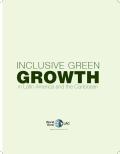Developing countries have collectively displayed relatively high growth rates in the last decade. Although large disparities still persist in standards of living, low and middle income countries averaged economic growth of 6.2 per cent between 2000 and 2008, pulling 325 million people out of poverty (World Bank, 2010). Global growth has been accompanied by environmental degradation and in some cases there are growing numbers of people still living in poverty. Key questions for development planning today in countries include: Can developing countries strike a balance between economic growth, societal well-being and environmental protection? Can inclusive, green growth be a way forward? This report presents a case study on Cambodia designed to answer these questions. The case study draws on several sources of information to compile a "snapshot" of the situation today. In particular, qualitative information was gathered through a two-day, multi-stakeholder workshop and through bilateral interviews conducted with relevant actors from both public and private sectors.
The OECD has developed a Policy Guidance with information and advice on how to facilitate the integration of adaptation within development processes. While efforts to integrate climate change adaptation will be led by developing country partners, international donors have a critical role to play in supporting such efforts as well as in integrating consideration of adaptation within their own plans and activities. To this end, partners and donors alike need operational guidance.
The objectives of the OECD Policy Guidance are to: i) promote understanding of the implications of climate change on development practice and the associated need to mainstream climate adaptation in development co-operation agencies and partners countries; ii) identify appropriate approaches for integrating climate adaptation into development policies at national, sectoral and project levels and in urban and rural contexts; and iii) identify practical ways for donors to support developing country partners in their efforts to reduce their vulnerability to climate variability and climate change.
India’s sustained and rapid economic growth offers an opportunity to lift millions out of poverty. But this may come at a steep cost to the nation’s environment and natural resources. Greening India's Growth: Costs, valuations and trade-offs analyzes India’s growth from an economic perspective and assesses whether India can grow in a “green” and sustainable manner.
This policy brief reviews the challenges of African urbanization as well as opportunities for sustainable development in the region. It notes that making urban areas green, inclusive, and resilient is part of the agenda for cities to be successful in the short and medium term. To acheive this, the policy brief notes that there must be: i) a clear vision; ii) coordination between city and national policies; iii) planning and integration of policies; and iv) learning from others. The brief concludes that part of the challenge of the coming decade is how to manage urbanization well by capturing long-term benefits without incurring unnecessary long-term costs. Pursuing a sensible green growth strategy is part of the solution.

